
Original Link: https://www.anandtech.com/show/2113
Mid-Range DDR2-800 from G.Skill
Many readers have been looking for DDR2-800 as memory prices sky-rocketed over the last couple of months. Now that memory prices are dropping, there is less pressure to save money with DDR2-800 instead of top-line DDR2-1000 or DDR2-1066. However, the question still remains whether a step down to DDR2-800 will save a few bucks while delivering performance about as good as the top DDR2 memory.
Almost every major memory manufacturer has DDR2-800 parts, but the ones of greatest interest to hobbyists are those from well-known high-end memory makers. G.Skill seemed to come out of nowhere a couple of years ago to establish themselves as a manufacturer of enthusiast memory. They got exposure and won credibility with Forum targeting and a sharply focused advertising campaign. G.Skill distributes a full line of desktop and notebook memory products, and the line includes a 2GB DDR2-800 4-4-4 kit at a mid-level price in the $300 range.
G.Skill DDR2-800 Specifications
Since it has only recently appeared on the US and European scene, it was a little surprising to find that G.Skill has been producing memory products since 1989. Manufacturing is based in Taipei, Taiwan and G.Skill serves memory markets in most of the world. The G.Skill website provides English, German, Chinese, and Korean versions - typical of the Taiwanese websites that cater to world markets.
As you will see on the website G.Skill targets the computer enthusiast, with a strong emphasis on overclocking and extreme performance. The DDR2 product line includes kits rated from DDR2-533 to DDR2-1067. DDR2-800 kits include both 1GB (2x512MB) and 2GB (2x1GB) kits rated at 5-5-5-15, 4-4-4-12, and 3-4-3-8.
Competitive with other high-end memory makers, G.Skill provides a Lifetime Warranty with their memory products. The RMA form can be accessed at the web site. Technical support and a Users Forum are also available at the website.
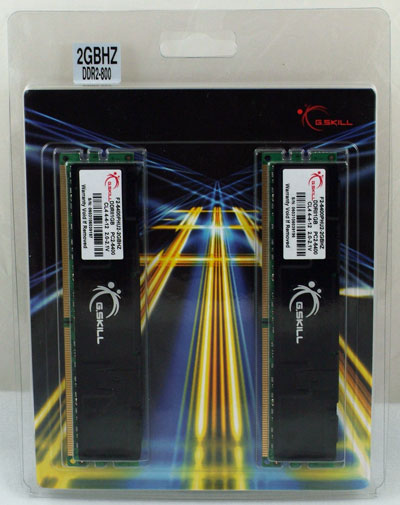
To satisfy readers' requests for a mainstream DDR2-800 memory product we selected the DDR2-800 2GB kit rated at 4-4-4-12. You can also buy cheaper DDR2-800 G.Skill kits at e-tailers like www.newegg.com. A 2GB G.Skill 5-5-5-15 kit sells for $210 to $260, some $40 to $90 less than the faster 4-4-4-12.
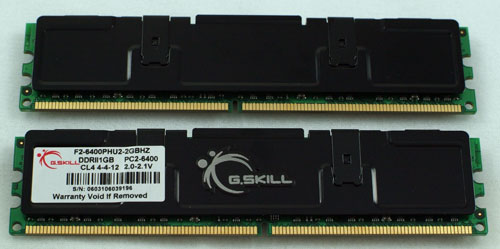
The G.Skill F2-6400PHU2-2GBHZ 2GB kit is supplied with attractive gloss black heatspreaders with a G.Skill logo in brushed metal. Many G.Skill DIMMs do not even have heat-spreaders, and G.Skill seems to reserve the heatspreaders for their top memory.
G.Skill builds their DIMMs with Micron D9 memory chips - the same chips we have described as top performers in every recent high-end memory review. However, the binning for these chips is a bit different. G.Skill uses Micron D9GMH chips rated at 333, 3ns in this 4-4-4-12 DDR2-800 kit. Most top-end DIMMs use D9GKX chips which are binned for higher specs. Still, with Micron D9 chips, we expect excellent overclocking with these G.Skill DIMMs.
| G.Skill F2-6400PHU2-2GBHZ Memory Specifications | |
| Number of DIMMs & Banks | 2 DS |
| DIMM Size | 1GB |
| Total Memory | 2 GB |
| Rated Timings | 4-4-4-12 at DDR2-800 |
| Rated Voltage | 2.0V to 2.1V |
While top-end Micron memory chips have easily delivered 3-3-3 timings at DDR2-800, G.Skill rates this memory kit at slower 4-4-4 timings. The good news, however, is the more modest 2.0V-2.1V specification for memory voltage. This is much lower than the 2.2V-2.3V that is normally required for DDR2-800 at 3-3-3 timings. It also represents memory voltages that are normally available even on more basic Core 2 Duo and AM2 motherboards.
The memory chips are slower bins from the best chips available. Timings are a bit slower and voltage specs are more reasonable. The question remains whether the G.Skill DDR2-800 4-4-4-12 kits are a top-of-the-line memory in disguise, or whether there are compromises to top performance? Does the cost/performance of these DDR2-800 modules represent real value to buyers?
Memory Test Configuration
It was clearly illustrated in Conroe vs. AM2: Memory & Performance that DDR2 memory performance, in timings and required voltage, are equivalent on the AM2 and Core 2 Duo platforms. However, the first generation of AM2 on-processor memory controller does not support any memory timings below 3, or memory speeds above DDR2-800. Both these features are supported on the Intel platform. Timings of 2 are available for RAS-to-CAS and RAS Precharge, and DDR2-1067 is a memory speed option on most Intel motherboards. The lack of extended memory timings and memory speeds makes it more difficult to test the newest DDR2 memories rated at DDR2-1000, DDR2-1067, DDR2-1100, or even higher, on an AM2 platform
For all of these reasons, the Intel platform is the current AT test platform for DDR2 memory. The Core 2 Duo Extreme processor, which has available CPU ratios both up and down, is the processor of choice. When changes are made in future AMD and Intel products the memory test platform will be examined again.
The ASUS P5W-DH is the latest 975X board in the ASUS family and it fully supports the Core 2 processors, including Core 2 Quad. The P5W-DH Deluxe therefore replaced the P5W-D2-E premium used in past DDR2 reviews. A review of the updated ASUS P5W-DH Deluxe is available in the Conroe Buyers Guide.
Since most of the Core 2 Duo/Extreme processors run at a quad-pumped FSB of 1067 (base 266), instead of the FSB800 used on earlier Intel processors, the available options on the P5W-DH Deluxe at FSB1067 are particularly well-suited for benchmarking memory when a Core 2 chip powers the system.
| Memory Configuration Options/ASUS P5W-DH Deluxe Motherboard | ||||||||
| Auto | DDR2-400 | DDR2-533 | DDR2-667 | DDR2-711* | DDR2-800* | DDR2-889* | DDR2-1067* | |
| FSB-1067 | X | X | X | X | X | X | X | X |
| FSB-800 | X | X | X | X | X | |||
| FSB-533 | X | X | X | |||||
The memory test bench uses the following components:
| Memory Performance Test Configuration | |
| Processor | Intel Core 2 Duo X6800 (Dual core, 2.93GHz, 4MB Unified Cache) |
| RAM | 2X1GB G.Skill DDR2-800 2x1GB Patriot DDR2-1066 2x1GB Super Talent DDR2-1000 2x1GB TEAM DDR2-1000 2 x 1GB Corsair CM2X1024-6400C3 2x1GB OCZ Ti Alpha PC2-8000 VX2 |
| Hard Drive | Hitachi 250GB SATA2 enabled (16MB Buffer) |
| Video Card | 1 x EVGA 7900GTX - All Standard Tests |
| Video Drivers | NVIDIA 91.47 |
| CPU Cooling | Tuniq Tower 120 |
| Power Supply | OCZ PowerStream 520W |
| Motherboard | ASUS P5W-DH Deluxe (Intel 975X) |
| Operating System | Windows XP Professional SP2 |
| BIOS | AMI 1407 (October 2, 2006) |
Core 2 Duo is as much as 35 to 40% faster than the earlier Intel Presler, which makes comparing memory performance between the two processors impractical. Therefore the only results shown in this review are DDR2 memories tested on the X6800 (Core 2 Duo) platform.
Stock Memory Performance
Most Intel Socket T (Socket 775) motherboards provide a wide range of memory ratios that match available DDR2 memory. End-users can select the memory ratio that matches their DDR2 memory speed. Our memory testing begins with the same approach. We first test all of the stock ratios at the fastest stable timings we can achieve at the given ratio. With ratios, CPU speed remains the same at 2.93GHz in our memory test bed, and memory speed is varied by selecting different ratios.
There are some downsides to this approach. With the memory controller in the chipset, instead of part of the processor as in AM2 systems, there is a small performance penalty for speeds other than a 1:1 ratio (DDR2-533 in this case). The performance penalty is actually very small and has minimal impact on test results. As a result memory scales nicely through the various speed options.
 |
| Click to enlarge |
DDR2 memory is then pushed from the highest stock ratio that could be achieved in testing - in this case 1067 - to the highest FSB speed at the stock multiplier. In the case of the G.Skill DDR2-800 speeds higher than DDR2-1067 were not completely stable. While we could boot as high as DDR2-1100 we could not complete our memory benchmarks at speeds above DDR2-1067 with the maximum 2.4V available on the ASUS P5W-DH. Boards with an extended top voltage range, like the DFI 590 for AM2, may be able to squeeze even more performance from these G.Skill DIMMs.
It is also worth pointing out that two sets of DDR2-800 benchmarks were run. The G.Skill memory required more voltage than the more expensive Micron D9 chips to perform with stability at 3-3-3 DDR2-800 timings. The great news is that they could match the fast 3-3-3 timings we have seen on other Micron D9, but they required 2.35V to do this, where the more normal required voltage is 2.2V.
Many buyers of mid-range DDR2-800 memory will not have a high-end motherboard that can supply voltages like 2.35V in their system. For that reason we also tested the specified 4-4-4 timings at DDR2-800. Those results were a very pleasant surprise since we achieved stability with just 1.9V at 4-4-4-12 timings. This is a voltage that any Core 2 Duo or AM2 motherboard should be able to deliver.
You can also see that 2.35V was required to reach stable performance at DDR2-1067. The good news is that the G.Skill DDR2-800 can be overclocked to DDR2-1067, but you will need voltage to reach that overclock. While we did not include results in the chart we did try to see how far we could push the G.Skill with 5-5-5-15 timings and a more modest 2.0V. The memory remained stable to just above DDR2-1000 at 2.0V.
This performance pattern gives most every buyer some choices when using this G.Skill DDR2-800 in their system. If their board is voltage limited, the memory is still usable at slightly slower timings. If the board supplies a very wide voltage range, then you can likely squeeze even better timings from this memory with higher voltage.
Memory Bandwidth Scaling
Memory bandwidth normally improves with increases in memory speed and reductions in memory timings. This is best illustrated using Performance Scaling charts instead of the bar charts for individual speeds that were used in past memory reviews.
Since the results for high-end memory were so close at all tested speeds, the scale range was reduced to better show the small differences in these memory benchmark results. Please keep this in mind when viewing the charts, since a normal zero scale would make performance differences appear much smaller than these expanded scale charts. Maximum values for other memories at each speed are included in each chart for reference.
To evaluate memory bandwidth SiSoft Sandra 2007 Professional was used to provide a closer look at scaling for fast DDR2 memory.
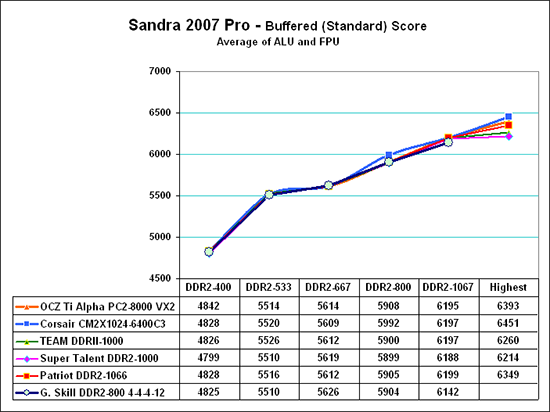
The most widely reported Sandra score is the Standard or Buffered memory score. This benchmark takes into account the buffering schemes like MMX, SSE, SSE2, SSE3, and other buffering tools that are used to improve memory performance. Buffered bandwidth performance of the G.Skill memory was virtually the same as the previously tested high-end DDR2 memory to DDR2-800. Performance does drop a bit at DDR2-1066 due to the slower timings required of the mid-range G.Skill memory.
The Buffered benchmark does not correlate well with real performance differences in games, so our memory bandwidth tests have always included an Unbuffered Sandra memory score. The Unbuffered result turns off the buffering schemes, and we have found the difference in Unbuffered results correlate well with real-world performance differences.
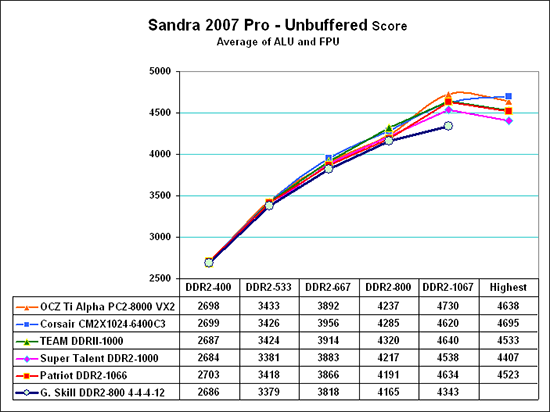
In Unbuffered tests we see the G.Skill mirrors the best memory tested to DDR2-800. Performance does drop a bit if you run at slower timings and reduced voltage at DDR2-800. Again, at DDR2-1067, the penalty of 5-5-5 timings compared to 4-3-4 causes slightly lower results with the G.Skill. It is worth pointing out, however, that memory bandwidth, both buffered and Unbuffered, continues to increase with memory speed even though memory timings are a great deal slower at DDR2-1067.
We also compared results with Version 1.5 of Super Pi - comparing the time to calculate 2 million places of Pi at the different memory speeds. This benchmark measures pure number crunching.
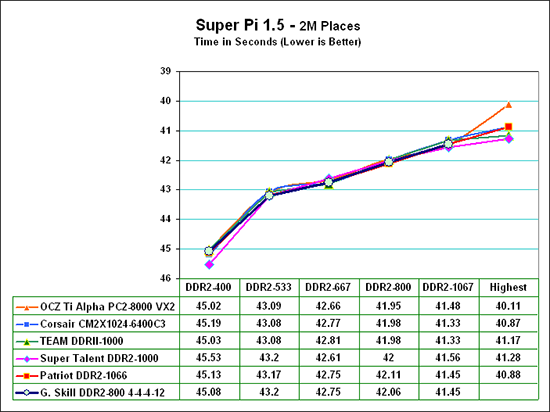
Super Pi results continue to improve all the way to the highest speed that could be reached with stability with each memory. The second item that stands out is how very close the results with all the memories really are.. All 6 memories perform very similarly with just two exceptions. The G.Skill performs similarly until DDR2-1067 where slower timings finally provide a penalty. The Super Talent drops off a bit at the top and bottom due to slightly slower timings in those ranges. While performance is very close, Super Pi scaling charts continue to show the useful sensitivity of Super Pi as a measurement of memory performance
Game Performance Comparison
Real-world benchmarks - specifically gaming benchmarks - provide the most useful measure of memory performance if you keep in mind what they represent. Memory is just one small part of overall gaming performance, and the AnandTech benchmarks keep everything the same except memory speed. Even the CPU speed is kept constant (except for the overclocking test). As a result performance improvements in FPS are very small because the only factor influencing the test results is memory speed. Many factors affect system performance, and memory speed is just one of those factors.
Since the results for high-end memory were so close at all tested speeds, the scale range was reduced to better show the small differences in these memory benchmark results. Please keep this in mind when viewing the charts, since a normal zero scale would make performance differences appear much smaller than these expanded scale charts. Maximum values for other memories at each speed are included in each chart for reference.
The AT memory test suite uses Far Cry, Half-Life 2 and Quake 4 for memory testing because they are sensitive to memory performance.
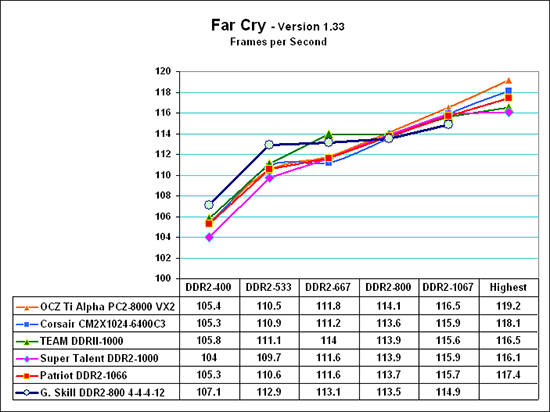
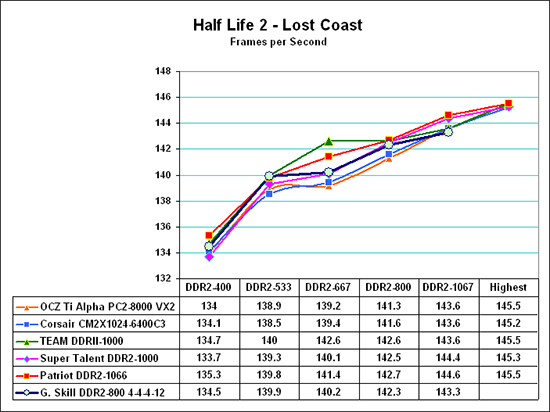
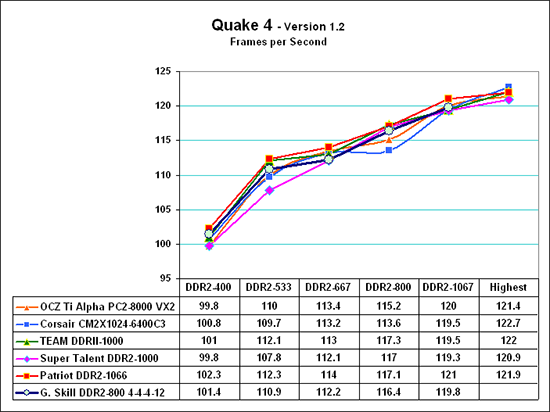
It is really interesting that memory is varying from 3-2-2-6 timings at DDR2-400 all the way to 5-5-5-15 timings at DDR2-1067. Despite the rapid drop in memory timings, all three games continue to show improvement in frame rates as memory speed increases. Put another way, performance continues to improve as memory speed increases This is the best evidence you will find to prove that increasing memory speed does increase performance - even to DDR2-1067 and beyond. The G.Skill DDR2-800 performance was as we expected. Results were virtually the same as the best DDR2 we have tested to DDR2-800, with a drop off due to slower timings at DDR2-1067. Memory speed can definitely improve system performance, but not to the extent of an upgraded video card or a higher speed processor.
Overclocking Performance (Highest Ratio at Highest Speed)
The G.Skill DDR2-800 performed extremely well to its rated speed DDR2-800. It also was able to reach beyond rated speed to the next standard speed of DDR2-1066. This is outstanding performance for a mid-priced memory rated at DDR2-800. Performance was as we might expect with Micron D9 memory chips, except the more relaxed binning of the D9GMH was apparent. More voltage and/or relaxed timings were required at DDR2-800 and above than we have seen in past reviews of Micron D9 based memory.
With a maximum available voltage of 2.4V, we had no head room at all above DDR2-1066. We do suspect, however, that this memory can likely go even further on boards that can supply higher voltages.
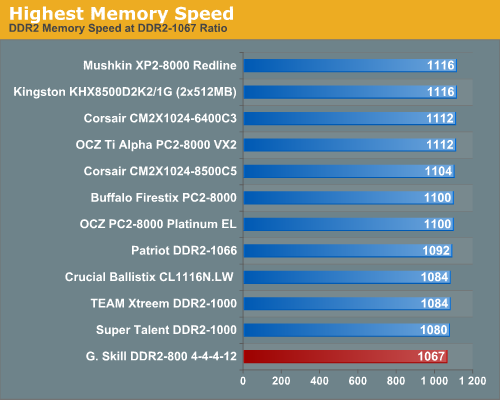
It is rare that a mid-range DDR2-800 memory can reach to DDR2-1067. However, our results are fairly typical of performance that has been measured with these DIMMs. We have seen reported results from around DDR2-1000 to DDR2-1100 as top overclock. Quite a few reported the same results we found in our testing, which is a top stable speed of DDR2-1067. Keep in mind that overclocking is never a guarantee, but the overclocking results we found with G.Skill DDR2-800 4-4-4-12 were typical of performance found by others..
Final Words
The best DDR2 memory in the market is able to run at DDR2-800 3-3-3 timings and DDR2-1066 at 4-3-4. Performance at these settings is the best we have seen for DDR2, and they remain the standard against which other DDR2 memory is measured. It is also worth repeating that all of the best DDR2 memory we have tested has been built with Micron D9 memory chips, which have set the pace for high-end DDR2 memory performance.
What a pleasant surprise then to find G.Skill DDR2-800 4-4-4-12 memory, with a mid-range price, built with Micron D9 memory chips. In fairness it is not exactly the same chip, since these Micron D9, designated D9GMH, are binned for lower performance than the very best, which are designated D9GKX. Still, we are dealing with the same excellent base memory chip, which have come through different sorts.
This same chip, binned to a lower speed and timings, does manage to reach the same performance level as the best at DDR2-800, but it requires much higher voltage to reach the 3-3-3 timings. However, if you are willing to compromise a bit, you can achieve the rated DDR2-800 at 4-4-4 timings with a very average 1.9V memory voltage. The G.Skill also became one of the few DDR2-800 kits tested at AnandTech that actually reached DDR2-1067. That memory speed required all our board could deliver at 2.35V to 2.4V and the timings still could not match the best D9 we have tested - 5-5-5 with G.Skill compared to 4-3-4 with the best D9-based DIMMs. However, this mid-priced memory acquitted itself very well, delivering more than we expected in our memory test suite.
The G.Skill DDR2-800 4-4-4-12 is not a ringer as you still get more with the very best money can buy - at DDR2-1067 and beyond. In other words you get what you pay for in this case. However, if DDR2-800 is as high as you will go, or DDR2-1067 at slower timings is still fine, then the G.Skill does deliver great value. It can be driven to the exact same memory speeds and timings as the best you can buy up to DDR2-800, although it will require more voltage to get there. If you don't want to use, or don't have that higher voltage available, then the G.Skill still perform\s at rated timings at a very respectable and always available 1.9V at DDR2-800.
We asked in the beginning if the G.Skill mid-priced DDR2-800 4-4-4-12 delivered value. Since you can reach all the same timings up to DDR2-800 if you have the voltage to supply, then it certainly can perform just as well as top-line to DDR2-800. The F2-6400PHU2-2GBHZ can also reach to DDR2-1067, with the performance improvements that can bring, although it does require slower timings than the best DDR2 tested at AnandTech. Finally, for those budget buyers who are using motherboards that can not supply voltages above 2.0V to 2.1V, the G.Skill will run at DDR2-800 4-4-4-12 at a very modest 1.9V. Overall, the G.Skill DDR2-800 gives excellent value, matching or coming close to the best we have tested to DDR2-800 with excellent overclocking beyond. There are certainly better performing DDR2 kits available, including some from G.Skill themselves, but for the money you will pay you definitely receive excellent value with this G.Skill 2GB DDR2-800 kit.







